Haddon Hall
Haddon Hall is an English country house on the River Wye near Bakewell, Derbyshire, a former seat of the Dukes of Rutland. It is currently the home of Lord Edward Manners (brother of the current Duke) and his family. In form a medieval manor house, it has been described as "the most complete and most interesting house of [its] period".[3] The origins of the hall date to the 11th century. The current medieval and Tudor hall includes additions added at various stages between the 13th and the 17th centuries.
| Haddon Hall | |
|---|---|
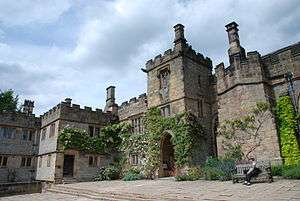 Haddon Hall in 2010 | |
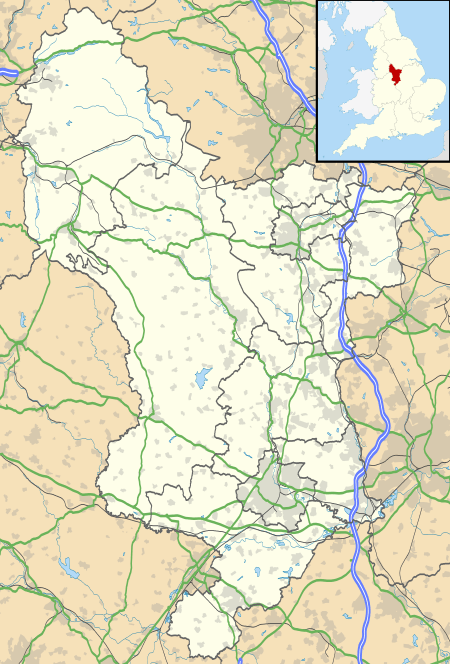 Location within Derbyshire | |
| General information | |
| Type | Country house |
| Town or city | Bakewell, Derbyshire |
| Country | United Kingdom |
| Coordinates | 53.1939°N 1.6498°W |
| Website | |
| www | |
Listed Building – Grade I | |
| Official name | Haddon Hall |
| Designated | 29 September 1951 |
| Reference no. | 1334982[1] |
National Register of Historic Parks and Gardens | |
| Designated | 4 August 1984 |
| Reference no. | 1000679[2] |
The Vernon family acquired the Manor of Haddon by a 12th-century marriage between Sir Richard de Vernon and Alice Avenell, daughter of William Avenell II. Four centuries later, in 1563, Dorothy Vernon, the daughter and heiress of Sir George Vernon, married John Manners, the second son of Thomas Manners, 1st Earl of Rutland. A legend grew up in the 19th century that Dorothy and Manners eloped. The legend has been made into novels, dramatisations and other works of fiction. She nevertheless inherited the Hall, and their grandson, also John Manners, inherited the Earldom in 1641 from a distant cousin. His son, another John Manners, was made 1st Duke of Rutland in 1703. In the 20th century, another John Manners, 9th Duke of Rutland, made a life's work of restoring the hall.
History
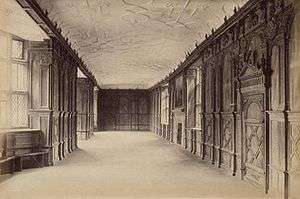
The origins of the hall date to the 11th century. William Peverel held the manor of Haddon in 1087, when the survey which resulted in the Domesday Book was undertaken. Though it was never a castle, the manor of Haddon was protected by a wall after a licence to build one was granted in 1194.[4] The hall was forfeited to the Crown in 1153 and later passed to a tenant of the Peverils, the Avenell family. Sir Richard de Vernon acquired the manor in 1170 after his marriage to Avice Avenell, the daughter of William Avenell. The Vernons built most of the hall, except for the Peveril Tower and part of the Chapel, which preceded them, and the Long Gallery, which was built in the 16th century.[5][6] Richard's son, Sir William Vernon, was a High Sheriff of Lancashire and Chief Justice of Cheshire.[7] Prominent later family members include Sir Richard Vernon (1390–1451), also a High Sheriff, MP and Speaker of the House of Commons.[7] His son Sir William was Knight-Constable of England and succeeded him as Treasurer of Calais and MP for Derbyshire and Staffordshire; his grandson Sir Henry Vernon KB (1441–1515) Governor and Treasurer to Arthur, Prince of Wales, married Anne Talbot daughter of the Earl of Shrewsbury and rebuilt Haddon Hall.[7]
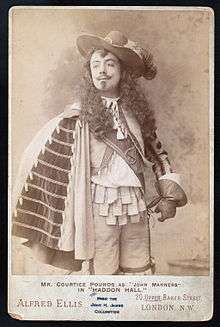
Sir George Vernon (c. 1503 – August 31, 1565) had two daughters, Margaret and Dorothy. Dorothy married John Manners, the second son of Thomas Manners, 1st Earl of Rutland in 1563.[8] Sir George supposedly disapproved of the union, possibly because the Manners were Protestants while the Vernons were Catholics, or possibly because the second son of an earl had uncertain financial prospects.[9] According to legend, Sir George forbade John Manners from courting the famously beautiful and amiable Dorothy and forbade his daughter from seeing Manners.[10] Shielded by the crowd during a ball given at Haddon Hall by Sir George in 1563, Dorothy slipped away and fled through the gardens, down stone steps and over a footbridge where Manners was waiting for her, and they rode away to be married.[11] If indeed the elopement happened, the couple were soon reconciled with Sir George, as they inherited the estate on his death two years later.[11][12] Their grandson, also John Manners of Haddon, inherited the Earldom in 1641, on the death of his distant cousin, George, the 7th Earl of Rutland, whose estates included Belvoir Castle.
That John Manners' son was John, the 9th Earl, and was made 1st Duke of Rutland in 1703. He moved to Belvoir Castle, and his heirs used Haddon Hall very little, so it lay almost in its unaltered 16th-century condition, as it had been when it passed in 1567 by marriage to the Manners family. In the 1920s, another John Manners, the 9th Duke of Rutland, realised its importance and began a lifetime of meticulous restoration, with his restoration architect Harold Brakspear. The current medieval and Tudor hall includes small sections of the 11th-century structure, but it mostly comprises additional chambers and ranges added by the successive generations of the Vernon family. Major construction was carried out at various stages between the 13th and the 16th centuries. The banqueting hall (with minstrels' gallery), kitchens and parlour date from 1370, and the St. Nicholas Chapel was completed in 1427. For generations, whitewash concealed and protected their pre-Reformation frescoes.
The 9th Duke created the walled topiary garden adjoining the stable-block cottage, with clipped heraldic devices of the boar's head and the peacock, emblematic of the Vernon and Manners families. Haddon Hall remains in the Manners family to the present day[13] and is occupied by Lord Edward Manners, brother of the 11th Duke of Rutland.[6]
The house was Grade I listed in 1951[1] following the passing of the Town and Country Planning Act 1947. The estate and gardens were separately listed at Grade I in 1984 on the Register of Historic Parks and Gardens of Special Historic Interest in England.[2]
Layout
The hall stands on a sloping site, and is structured around two courtyards; the upper (north-east) courtyard contains the Peverel or Eagle Tower and the Long Gallery, the lower (south-west) courtyard houses the Chapel, while the Great Hall lies between the two. As was normal when the hall was built, many of the rooms can only be reached from outside or by passing through other rooms, making the house inconvenient by later standards.
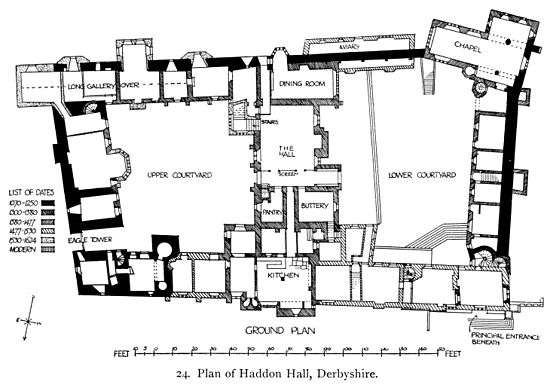
In literature and the arts
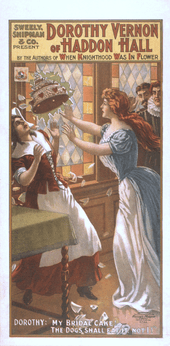
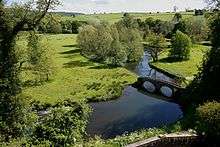
The hall has figured prominently in a number of literary and stage works, including the following, all of which describe the Vernon/Manners elopement:
- A story entitled King of the Peak – A Derbyshire Tale, written by Allan Cunningham, was published in the London Magazine in 1822.
- An 1823 novel, The King of the Peak – A Romance, in three volumes, was written by William Bennett (1796–1879), writing under the pseudonym Lee Gibbons.[14]
- "The Love Steps of Dorothy Vernon", a short story by Eliza Meteyard (1816–1879), writing under a pseudonym in 1849, was the first full-blown version of the legend. It was first published in the December 29, 1849 issue of Eliza Cook's Journal and then in The Reliquary, October 1860, p. 79.[15]
- A light opera, called Haddon Hall, with music by Arthur Sullivan and a libretto by Sydney Grundy, premiered in London in 1892.
- A novel called Dorothy Vernon of Haddon Hall was written in 1902 by American Charles Major and became a best seller.
- A play of the same name, based on Major's novel, was written by American playwright Paul Kester. It debuted on Broadway in 1903.[16]
- Fred Terry and his wife Julia Neilson adapted that play for London, calling it Dorothy o' the Hall, where it played in 1906.[17][18]
- A 1924 film, Dorothy Vernon of Haddon Hall, starring Mary Pickford, was adapted by American screenwriter Waldemar Young (grandson of Brigham Young) from the Major novel.[19]
- The Hall features in Philip Hensher's 2008 novel The Northern Clemency.
Frederick Booty, the English watercolourist, painted Haddon Hall several times, including pictures of the peacocks in the gardens.[20]
In cinema and television
The 1985 documentary TV series Treasure Houses of Britain showcases Haddon Hall at the very end of the last episode. The interior and exterior of Haddon Hall (including the Long Gallery) were used in 1986 as Prince Humperdinck's castle in The Princess Bride. In 1990, the hall was the set for the castle of the giants at Harfang in the BBC's adaptation of The Silver Chair, one of C.S. Lewis's Chronicles of Narnia. Franco Zeffirelli chose Haddon Hall as the location for his 1996 film Jane Eyre, and the Hall featured in the 1998 film Elizabeth. It also appeared in the 2005 film version of Pride & Prejudice. It was the setting in 2006 of Thornfield Hall in Diederick Santer's 2006 BBC television version of Jane Eyre[21] and in Cary Fukunaga's 2011 film of Jane Eyre.[19] The hall was the setting for A Tudor Feast at Christmas, a BBC2 documentary recreation of a Tudor banquet (first broadcast Christmas 2006) by the team of academics from Tales from the Green Valley,[22] and was a location for the BBC Television series Gunpowder (2017).[23]
References
- Historic England. "Haddon Hall (Grade I) (1334982)". National Heritage List for England. Retrieved 5 April 2019.
- Historic England. "Haddon Hall (Grade I) (1000679)". National Heritage List for England. Retrieved 5 April 2019.
- Gotch JA, The Growth of the English House, 1909
- Davis, Philip. "English Licences to Crenellate: 1199-1567", The Castle Studies Group Journal 20, 2007, pp. 226–45
- "Haddon Hall", PeakDistrictInformation.com, accessed 26 July 2015
- "Haddon Hall: History and Virtual Tour; Owners of Haddon Hall", HaddonHall.co.uk, accessed 15 November 2012
- Brydges, Edgerton. Collins's Peerage of England, Vol. VII (1812), pp. 399–401
- Trutt, p. 24
- Walford, Edward. "Tales of Our Great Families: The Heiress of Haddon Hall" Archived 25 February 2012 at the Wayback Machine. 1877, Haddon Hall Books edition 2010, accessed 10 September 2011
- Trutt, p. 7
- Trutt, p. 8; Although it is known that Dorothy's older sister, Margaret, had been married for several years before Dorothy's marriage, in many versions of the legend, the ball is a pre-wedding celebration for Margaret.
- See "Haddon Hall". Britain Express, accessed 6 September 2011; and "Haddon Hall" Archived 2007-08-16 at the Wayback Machine. Picturesque England, mspong.org, accessed 6 September 2011. The story was briefly mentioned in the personal journal of Absalom Watkin in 1817, after a visit to the Hall and its caretaker William Hage, but in its full-blown form, it was first published (or first documented, if one believes it to be history rather than legend) in The King of the Peak – A Derbyshire Tale, written by Allan Cunningham in 1822 and published in the monthly London Magazine. The story was romanticized further and published in many forms thereafter.
- "Haddon Hall – the Estate". The Gilbert and Sullivan Archive, accessed 6 September 2011
- Trutt (2006), p. 26
- Trutt (2006), p. 39
- "Dorothy Vernon of Haddon Hall" - first Broadway production
- Smith, p. 28, fn.1
- Trutt, David. Introduction and libretto to Dorothy o' the Hall, accessed 5 August 2010
- "Films and Television programmes featuring Haddon Hall, The Estate Office, Haddon Hall, accessed 26 April 2018
- Art auction results for Frederick Booty. Findartinfo.com. Retrieved 23 March 2010.
- "Thornfield Hall in Masterpiece Theatre's Jane Eyre, hookedonhouses.net, 12 January 2009
- "A Tudor Feast at Christmas
- Hordley, Chris (20 October 2017). "Where was BBC's Gunpowder Filmed?". Creative England. Retrieved 16 December 2017.
Sources
- Trutt, David, Dorothy Vernon of Haddon Hall (2006)
Further reading
- Rayner, Samuel. The History and Antiquities of Haddon Hall (1836)
- Smith, G. Le Blanc. Haddon, the Manor, the Hall, Its Lords and Traditions (1906).
External links
| Wikimedia Commons has media related to Haddon Hall. |
| Wikisource has the text of the 1911 Encyclopædia Britannica article Haddon Hall. |
- Haddon Hall official website
- Haddon Hall historical and literary website
- Images of England — Haddon Hall
- Detailed description of the hall and some of its history
- Information about the Hall
- British Tours — QuickTime VR Panorama of Haddon Hall
- Films and TV productions that have used Haddon Hall as a location at The Internet Movie Database
- Dorothy Vernon of Haddon Hall at the Internet Broadway Database
